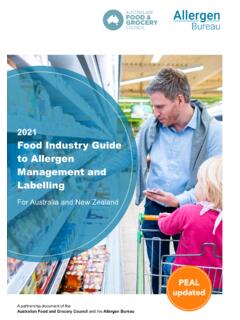Transcription of Managing Allergens in Food - The Allergen Bureau
1 21/10/20131 Managing Allergens in FoodSimon Brooke-Taylor PhD27 September 2013 Adverse Reactions to FoodImmune responses to food IgE mediated - food allergy usually protein non-IgE (eg coeliac disease - gluten) food Intolerance chemical or physiological reaction to food (eg lactose)Toxicity Foodborne pathogen Pharmacologically active food component21/10/20132 IgE Mediated food AllergyUtrecht Center For food of food Allergy Itching, burning and swelling around the mouth Runny nose Skin rash (eczema) Hives (urticaria skin becomes red and raised) Diarrhoea, abdominal cramps Breathing difficulties, including wheezing and asthma Vomiting, nausea Anaphylaxis - Can be Fatal21/10/20133 Prevalence of food Allergy 4% of all Americans (approximately 12 million) of adults 6% of children under 3 years of age Most food allergies resolve in first 10 years of life Cow milk allergy in Egg allergy in Peanut allergy in peanut, tree nut, fish, and shellfish allergies often lifelong eg only twenty percent outgrowing peanut allergyPeanut N Europe, N America, Australia, New Zealand why not Asia?
2 Preparation, boiled/fried vs roasted?Celery SwitzerlandChestnut KoreaFood Allergy - Regional Variation21/10/20134 How Allergens Get Into FoodDirect Addition Allergens + Products of Allergens food Ingredients food Additives Processing AidsCross-Contact Transport & storage of raw materials shared equipment/facilities Common processing facilitiesEstablishing food Allergen Thresholds Why? Mandatory labelling exemptions Precautionary labelling21/10/20135 Mandatory Allergen Labelling Cereals containing glutenMilkEggCrustaceaMolluscs (EU)FishPeanutsSoybeansSesame seedsTree Nuts (EU named nuts)Added Sulphites 10 mg/kgCelery (EU)Lupins (EU)Mustard (EU)Exemptionscase by caseisinglass ANZ, EU fish gluten(EU)coconut (ANZ)alcohols from cereals (ANZ,EU), whey (EU), treenuts (EU),glucose syrups and maltodextrin (EU)lactitol (EU)refined soybean oils, tocopherols, phytosterols and stanols (EU)Tree Nuts of Concern almonds Brazil nuts cashews hazelnuts (filberts) macadamia nuts pecans pine nuts (pignolias) pistachio nut are part of the legume family (like soy)
3 And are not tree nuts21/10/20136 Precautionary Labelling2005 Concern about overuse of may contain AFGC Allergen Risk Assessment Project Development of a standardised Allergen risk assessment tool which can be used to assist in determining appropriate voluntary Allergen labellingstatementsVITALV oluntary Incidental Trace Allergen LabellingSystem21/10/20137 PIF VITAL Guidelines VITAL Calculator Unexpected Allergens in food links of international Allergen regulations Presentations Helplinedownload from website (free)Alllergen Bureau Resources21/10/20138 Guidance Document more detailed New definitions and expanded explanations Attempts to avoid common mistakes Includes detailed information about Allergen analysis Available at ProcedureElements of VITALI ncorporate in HACCP food Safety Programme1. Ingredient and Processing Impact Assessment2.
4 Compare with VITAL Grid integrated in VITAL calculator3. Identify Action Levels & recommended labelling may be present: allergen4. Record Assumptions, Validate, Monitorlabelling is not an excuse for not implementing GMP!21/10/20139 Ingredient and Processing Impact Assessment Identify relevant Allergens (intended country of sale) added Allergens Identify and quantify cross contact Allergens due to ingredients due to processing VITAL Calculator Calculate total cross contact Allergen in final product Identify typical portion / serving size Compare with threshold concentration from VITAL Grid if ACTION Level 2 Can procedures be modified to reduce cross -contact? review before deciding to labelVITALCALCULATOR21/10/201310 VITALGRIDE mbedded in VITAL calculatorVITAL Grid & Action LevelsReference Dosemg Allergen proteinReference AmountorServing Sizegm of foodAction Level 2precautionary labelAction Level 1no label+Action Level Thresholdmg/kg21/10/201311 VITAL Grid Quantity100gmAllergenReference DoseTotal protein (mg)
5 Level of protectionActionNo Level 1 LabelActionPrecautioneryLevel <2 ppm>2 <1ppm> and 95% lower confidence interval of the ED05< ppm> ppmTree and 95% lower confidence interval of the ED05<1 ppm>1 ppmSoy195% lower confidence interval of the ED05 for soy flour<10 ppm>10 ppmGluten containing cereals195% lower confidence interval of the ED05<10 ppm<10 lower confidence interval of the ED05<2 ppm>2 ppmCrustacea1095% lower confidence interval of the ED05<100 ppm>100 ppmFin <1ppm> lower confidence interval of the ED05< ppm> ppmLupin495% lower confidence interval of the ED05<40 ppm>40 ppmRisk Based Thresholds for VITAL21/10/201312 Allergen cross Contact - Population at Riskfrom Crevel et al 2008 Original VITAL Scientific Approach Key data source FDA Threshold Working Group Report (2006) Used LOAELs from FDA TWG tables Applied uncertainty factors (UF) to set reference doses Expressed action levels in concentration (ppm) rather than amount of protein(mg); 5 g serving size (teaspoon/mouthful) Most VITAL min levels set at >2 ppm (exceptions fish, milk, soy, gluten) very conservative21/10/201313 Vital Review 2010 Quantitative risk assessment Some allergic individuals are more sensitve than others!
6 Bindslev-Jensen et al (2002) possible to derive a statistically based populaton dose response curve for Allergen reactions Crevel et al (2007) - concept of eliciting dose (ED) representative of the whole allergic population EDp - dose of Allergen that produces a response in p% of the allergic Distribution Modellingfrom Crevel et al food Chem Toxicol 200721/10/201314100%50%5%10%log normal, log logistic, or Weibull model**Dose Distribution ModellingVital Review 2010 Quantitative risk assessment Bindslev-Jensen et al (2002) possible to derive a statistically based dose response curve for Allergen reactions Crevel et al (2007) - concept of eliciting dose (ED) representative of the whole allergic population EDp - dose of Allergen that produces a response in p% of the allergic population. But how to access data for quantitative modelling?
7 21/10/201315 VITAL Scientific Expert Panel (VSEP) 2011 Role: Advise Allergen Bureau on VITAL review Collaboration between: The Allergen Bureau ; FARRP ( food Allergy Research and Resource Program (University of Nebraska) and; TNO (The Netherlands Organisation for Applied Scientific Research) Access to new data sources Expertise in Allergen Risk AssessmentVITAL Scientific Expert Panel (VSEP)Panel Members: Dr Steve Taylor(FARRP) Dr Joseph Baumert(FARRP) , supported by Mr Benjamin Remington (FARRP), Dr Geert Houben(Program Manager food Safety,TNO. NL) Dr Rene Crevel(Allergy & Immunology, Unilever) Dr Katie Allen(Paediatric Gastroenterologist/Allergist , Royal Chrildrens Hospital, University of Melbourne), supported by Ms Jennifer Koplin Dr Simon Brooke Taylor ( food Safety & Risk Analysis Consultant, AB) The VSEP received significant support from Astrid Kruizinga, Ellen Dutman & Harrie Buist (TNO)21/10/201316 VSEP principles Scientifically & clinically sound, defensible and transparent Reference Dose expressed as mg of total protein with Action Level determined using the reference amount or serving size Exquisitely allergic consumers not accounted in VITAL Assume do not eat processed foods without seeking advice from manufacturer first21/10/201317 VSEP principles (cont))
8 Level of Acceptable Risk protection for vast majority of allergic individuals 95-99% Reference doses set with highest degree of safety Increasing availability of clinical data = increasing confidence in models Drives research to fill the data gaps Potentially opens up choice to a larger number of safe foods Reference Doses subject to ongoing reviewThe VSEP Overarching Scientific Approach Quantitative risk assessment Threshold predictive for the whole population Representative population weighted to include both individuals who react to very low amts & those who require large amts to provoke response Statistically based risk assessment - population thresholds Requires individual threshold doses from a sufficiently large number of allergic individuals Analysis of the clinical literature conducted determine if sufficient quantity and quality of published and unpublished data accessible21/10/201318 Working ExamplesProbability distribution models for individual peanut thresholds (as whole peanut).
9 Published (a) Log-Logistic, (b) Log-Normal, (c) Weibull. Taylor et al 2009ED10 doses for whole peanut as assessed by three probability distribution ED10 95% CILog-Normal , , , Probability distribution curves (Weibull) of thresholds for peanut, hazelnut, cashew nut, cow s milk and hen s egg (as discrete doses in milligram of total protein of the allergenic food ) in an allergic pediatric population. Distribution based on LOAEL and NOAELs for objective Blom et al 2013 VSEP data point summary by AllergenAllen et al 201321/10/201320 VSEP Recommended Reference DosesAllergenProtein Level (mg)VITAL as generic tree nut protein isolates not soy & wheat allergic VITAL value appliedOverview VSEP approach used all available existing published data plus some unpublished data Implemented in VITAL 2 in 2012 ppm determined on actual serving size VITAL grid levels protect 95-99% of allergic consumers 99% desirable when sufficient data exists to allow statistically sound estimates Risk of mild, transitory objective reactions typically requiring no pharmacological intervention Exquisitely sensitive allergic consumers may not be fully protected (assume do not consume packaged foods)
10 No additional uncertainty factors needed because of use of ED01 or lower 95% confidence interval of ED05 Allergic populations in trials appear to be representative or skewed toward more highly sensitive (referral clinics, immunotherapy studies) 21/10/201321 VITAL Grid Quantity100gmAllergenReference DoseTotal protein (mg)Level of protectionActionNo Level 1 LabelActionPrecautioneryLevel <2 ppm>2 <1ppm> and 95% lower confidence interval of the ED05< ppm> ppmTree and 95% lower confidence interval of the ED05<1 ppm>1 ppmSoy195% lower confidence interval of the ED05 for soy flour<10 ppm>10 ppmGluten containing cereals195% lower confidence interval of the ED05<10 ppm<10 lower confidence interval of the ED05<2 ppm>2 ppmCrustacea1095% lower confidence interval of the ED05<100 ppm>100 ppmFin <1ppm> lower confidence interval of the ED05< ppm> ppmLupin495% lower confidence interval of the ED05<40 ppm>40 ppmThank youAllergen Bureau VITAL Mgt TeamRobin Sherlock - DTS FACTaFiona Fleming - FJ Fleming food ConsultingKirsten Grinter Nestle AustraliaAllergen Bureau Scientific Risk Analysis ConsultantSimon Brooke TaylorAllergen Bureau








